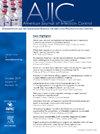预防牙科手术中气溶胶产生的微生物污染的策略:系统回顾和荟萃分析。
IF 3.8
3区 医学
Q2 INFECTIOUS DISEASES
引用次数: 0
摘要
背景:牙科实践中气溶胶的产生是感染控制的重要问题。本研究旨在探讨在牙科手术过程中控制和预防气溶胶产生的微生物的策略。方法:使用PRISMA指南通过电子数据库(PubMed、ScienceDirect、Cochrane Library、b谷歌Scholar和Scopus)进行系统搜索,使用特定关键词,如“气溶胶产生”、“牙科手术”和“预防”,对报告干预措施的研究进行系统搜索,包括漱口水和吸引装置,这些干预措施对牙科手术过程中产生的病原体有效。根据预先确定的标准纳入了符合条件的研究。在RevMan 5.4软件中采用随机效应模型计算合并疗效。使用robb -2.0和Robvis web应用程序进行质量评估。结果:本系统综述和荟萃分析纳入了19项研究。不同的干预措施,包括氯化十六烷基吡啶、氯己定、二氧化氯、过氧化氢、草药配方产品和吸引装置,已被确定为最常用的干预措施,以减少牙科手术期间的微生物污染。总体而言,这些干预措施被发现是有效的,总有效性为-46.64 (95% CI: -60.89至-32.38,I2=100%)。结论:本研究强调了综合使用抗菌漱口水和吸引器的多层面方法的重要性,以最大限度地减少在气溶胶产生的牙科手术过程中交叉污染和感染传播的风险,从而保障患者和牙科医护人员的健康和安全。数据可用性声明:本研究中提供的数据可向通讯作者索取。本文章由计算机程序翻译,如有差异,请以英文原文为准。
Strategies for preventing aerosol-generated microbial contamination in dental procedures: A systematic review and meta-analysis
Background
Aerosol generation in dental practice is a significant concern in infection control. This study aimed to investigate the strategies for controlling and preventing aerosol-generated microbes during dental procedures.
Methods
A comprehensive literature search was performed using Preferred Reporting Items for Systematic Reviews and Meta-analysis (PRISMA) guidelines through electronic databases (PubMed, ScienceDirect, Cochrane Library, Google Scholar, and Scopus) for studies reporting interventions, including mouthwash and suction devices, that were effective against pathogens generated during dental procedures. Predefined criteria identified eligible studies. Pooled efficacy was estimated using RevMan 5.4's random-effects model.Quality assessments were performed using RoB-2.0 and the Robvis web application.
Results
This systematic review and meta-analysis included 19 papers. Cetylpyridinium chloride, chlorhexidine, chlorine dioxide, hydrogen peroxide, botanical medicines, and suction devices are the most used dental therapies to minimise microbial contamination. Overall, these treatments showed success with a pooled effectiveness of -46.64 (95% CI: -60.89 to -32.38, I2=100%, p<0.00001).
Conclusions
This study emphasises the need for a multifaceted approach that uses antiseptic mouthwash and suction devices to reduce cross-contamination and infection transmission during aerosol-generated dental procedures, safeguarding patients and dental workforce.
求助全文
通过发布文献求助,成功后即可免费获取论文全文。
去求助
来源期刊
CiteScore
7.40
自引率
4.10%
发文量
479
审稿时长
24 days
期刊介绍:
AJIC covers key topics and issues in infection control and epidemiology. Infection control professionals, including physicians, nurses, and epidemiologists, rely on AJIC for peer-reviewed articles covering clinical topics as well as original research. As the official publication of the Association for Professionals in Infection Control and Epidemiology (APIC)

 求助内容:
求助内容: 应助结果提醒方式:
应助结果提醒方式:


